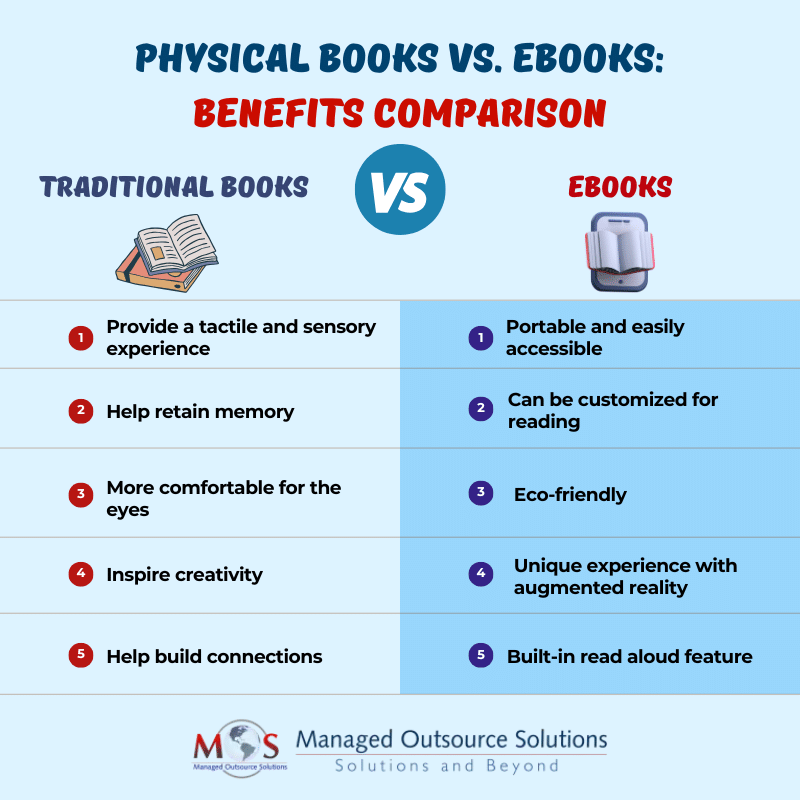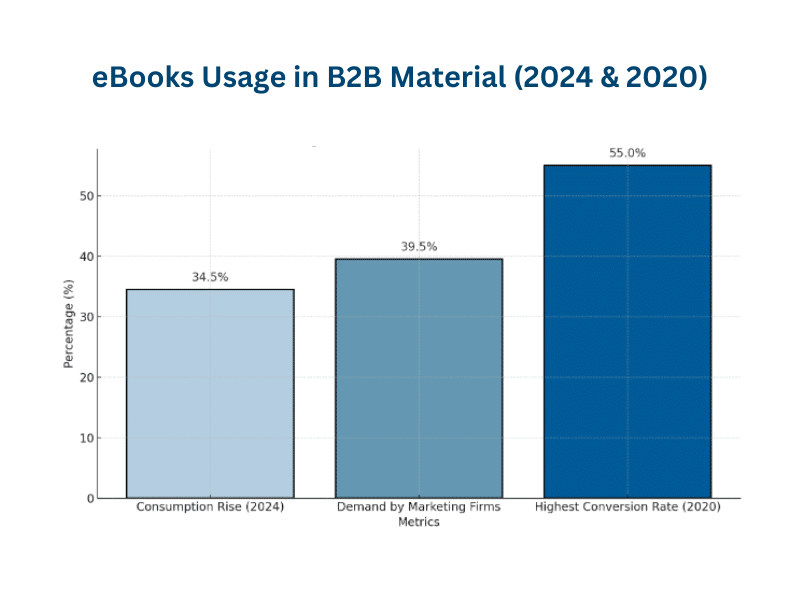Reading books opens up windows to new worlds. As Walt Disney said, “There is more treasure in books than in all the pirate’s loot on Treasure Island.” In this digital era, e-books have become a popular alternative to traditional print books. Ebook conversion services have revolutionized the publishing industry, transforming traditional books, scientific, technical and medical (STM) books, reports, brochures, catalogs, white papers, or any other type of file or document into attractive digital versions that can be read on a computer, tablet, or e-reader device. Even so, eBooks and traditional printed books continue to vie with each other to establish their position as the platform of choice. In order to serve a large community of digital users, authors are increasingly digitizing their books. Since eBooks offer a compelling reading and learning experience, schools and business organizations are increasingly using them for training purposes.
When comparing traditional books and eBooks, you will discover that while printed hardcover books are highly cherished for their authenticity and the physical satisfaction of holding a real book, e-books are more practical and far more portable. Factors like cost, portability, durability, reading conditions, and durability go into determining the choice between physical books and eBooks. Let’s dive into the benefits of printed books and eBook books.
Benefits of Traditional Books
Physical books offer unique value and benefits:
- More tactile in nature: Traditional books are more tactile. These books provide a feel that is entirely different from holding an e-reader. Printed books allow you to feel and smell the aroma of the textured pages and hear the flipping of pages. Well-designed books look and last a really long time. Above all, there is something that comes with turning pages, smelling the paper, and seeing permanent words printed on the pages.
- Help increase memory retention and focus: Several studies suggest that reading on paper rather than an electronic screen helps increase memory retention and focus. Printed books encourage deep reading, and allow the reader to better grasp and retain the meaning of the words. In a Norwegian study, one group of people was given a short story to read on an Amazon Kindle, while another group was given a paperback book. After both groups had completed reading the story, they were quizzed. The outcome was that, those who read the paperback were more likely to remember plot points in the right order.
- Suitable for readers with sleep problems and eye strain: EBook readers have strong backlights. These high levels of screen luminance from an electronic device can lead to visual fatigue, a condition marked by tired, itching and burning eyes. This exposure to artificial causes a lot of doctors and sleep scientists to recommend regular books over their electronic versions.
- Encourage creativity: When children read a physical book, they can better envision the story. Additionally, children’s books often feature eye-catching pictures that can ignite the young mind. This can inspire them to develop their own stories and characters, sparking creativity.
- Fosters bonding with caregivers: When a parent reads a book to a child, it builds an emotional connection. Children can discuss the story, share their thoughts and opinions, and ask questions, which promotes language development and key thinking skills. Importantly, the child will remember the experience for the rest of their life.
Advantages of eBooks
- More functional and easier to carry around: Ebook readers are portable and lightweight. Instead of carrying multiple bulky physical books, you can carry around thousands of book in one eBook reader.
- Benefit individuals with poor eyesight or reading disorders: E-books are beneficial especially for individuals with poor eyesight or reading disorders like dyslexia, as almost all e-readers or tablets provide a range of options for changing the text size and spacing of lines, thereby making eBooks easier to read. A study was conducted in Landmark High School in Prides Crossing, MA (USA), incorporating 103 high school students with lifelong histories of reading struggle (dyslexia). The study team observed reading comprehension and speed of these 103 students and found that students were able to read more effectively and with greater ease with the e-reader than reading on paper.
- Ubiquitously accessible: You can download Bbooks, store them for later use, and read them anywhere. Students can go read them even while travelling. Some eReaders offer offline accessibility, allowing you to read them even in the absence of an internet connection.
- Shareable: An eBook can be shared with many people at the same time. This ability promotes collaboration.
- Searchable: Ebooks allow you to easily search for any information, without having to turn page after page. These books have the ability to search through the whole book or possibly your entire library in seconds. It is possible to scroll the text with one finger, helping older readers to navigate through the texts with ease. E-books are also shareable. You can quickly email an e-book to yourself or a friend.
- Ease of publication: It may be free to publish information in digital formats, thereby avoiding the need to find an agent to secure a book deal with a publisher. Self-publishing a traditional book is not particularly cheap.
- Augmented Reality (AR): augmented reality books and publications merge the virtual world with reality, giving readers a unique experience. AR has the capability to incorporate interactive elements, such as games or videos, into educational content and children’s books. You can add external links to provide more details. The user can quickly and easily find a word or bookmark a certain page. By offering features like virtual tours and 3D projections, AR enhances the value of printed material. This technology introduces an additional dimension of information, including audio commentary and video footage, thereby enabling the creation of interactive applications and games that seamlessly integrate with the physical environment.
- Read aloud feature: Text-to-speech or read-aloud capabilities are built into e-books. This enables users to listen to the eBooks while they are too busy to read them, as when driving or doing housework. Children and adults with visual impairments or learning disabilities also benefit from this function. Additionally, it helps the user grasp the pronunciation of different words.
- Eco-friendly: eBooks are environmentally friendly, eliminating the need for paper printing, resulting in cost savings for publishers. Every year, about 3 million trees are used to produce 2.2 million books. Transporting the raw materials, the mill production process, and the final shipping all increase the carbon footprint in addition to chopping down trees. EBooks can eliminate all of this and considered more environmentally friendly overall.
- Lasts longer than traditional books: While physical books can degrade over time due to wear, tear, and environmental factors such as humidity or sunlight, eBooks are stored digitally, ensuring they remain in perfect condition indefinitely. They don’t suffer from pages yellowing, covers tearing, or spines breaking. Additionally, eBooks can be easily backed up and stored across multiple devices, reducing the risk of loss or damage. This makes eBooks a durable, long-lasting option.
Ebook Industry Trends
In this digital age, there is no going back. Ebooks have come a long way and not only allow for expanded reach but also better accessibility of content. Technavio estimates that the global eBook market size will grow by USD 8316.2 million from 2022 to 2027.
Ebooks are becoming more and more popular due to their ability to attract leads in both B2B and B2C marketing scenarios.
- With a 34.5% rise in consumption in 2024, eBooks continue to be the most widely used form of B2B material.
- With 39.5% of demand, they are also the most often employed content format by marketing firms and demand creation teams.
- Of all short-form written content, eBooks had the highest conversion rate7 in 2020, according to 55% of small firms.
The reader’s preferences ultimately determine which option is best for them, as both eBooks and traditional books provide unique advantages. While eBooks offer convenience, flexibility, and environmental benefits, conventional books provide an immersive physical experience. Some readers prefer a mix of the two forms, utilizing eBooks for reading when traveling or on the move and traditional books at home. Authors and publishers can utilize ebook conversion services to ensure a smooth transition between print and digital versions and enhance the reading experience for users worldwide.






